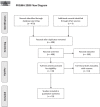Spinal Cord Stimulation for Gait Disorders in Parkinson's Disease
- PMID: 36683516
- PMCID: PMC9912734
- DOI: 10.3233/JPD-223284
Spinal Cord Stimulation for Gait Disorders in Parkinson's Disease
Abstract
Background: Spinal cord stimulation (SCS) is a therapeutic procedure widely used in the management of refractory chronic pain. Evidence from case reports and small descriptive studies has emerged suggesting a role for SCS in patients with gait dysfunction, such as freezing of gait (FoG) and postural imbalance. These are severely debilitating symptoms of advanced Parkinson's disease (PD).
Objective: To establish the current evidence base for the potential application of SCS on gait and balance dysfunction in PD patients.
Methods: Three online databases were screened for relevant manuscripts. Two separate searches and four different search strategies were applied to yield relevant results. The main parameters of interest were postural and gait symptoms; secondary outcomes were Quality of Life (QoL) and adverse effects.
Results: Nineteen studies fulfilled the inclusion criteria. Motor improvements using section III of the Unified Parkinson's Disease Rating Score (UPDRS-III) were available in 13 studies. Measurements to assess FoG reported the following improvements: FoG questionnaires (in 1/19 studies); generalized freezing parameters (2); and walkway/wireless accelerometer measurements (2). Parameters of postural imbalance and falling improved as follows: BBS (1); posture sagittal vertical axis (1); and generalized data on postural instability (8). Two studies reported on adverse effects. QoL was shown to improve as follows: EQ-5D (2); ADL (1); SF-36 (1); BDI-II (1); PDQ-8 (1); HDRS (1); and VAS (5).
Conclusion: SCS may have a therapeutic potential in advanced PD patients suffering from postural and gait-related symptoms. The existing evidence suggests that SCS positively affects patients' QoL with an acceptable safety profile in this patient population.
Keywords: Parkinson’s disease; balance; falls; freezing; gait; posture; review; spinal cord stimulation.
Conflict of interest statement
The authors have no conflict of interest to report.
Figures
References
-
- Shulman LM (2010) Understanding disability in Parkinson’s disease. Mov Disord 25, S131–S135. - PubMed
-
- Fasano A, Aquino CC, Krauss JK, Honey CR, Bloem BR (2015) Axial disability and deep brain stimulation in patients with Parkinson disease. Nat Rev Neurol 11, 98–110. - PubMed
-
- Moore O, Peretz C, Giladi N (2007) Freezing of gait affects quality of life of peoples with Parkinson’s disease beyond its relationships with mobility and gait. Mov Disord 22, 2192–2195. - PubMed
Publication types
MeSH terms
Grants and funding
LinkOut - more resources
Full Text Sources
Medical


